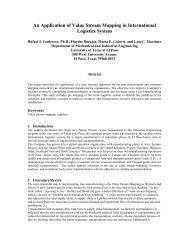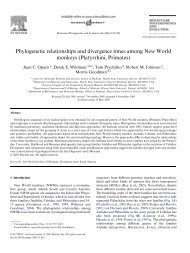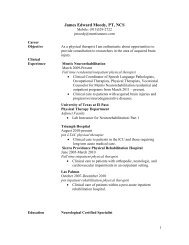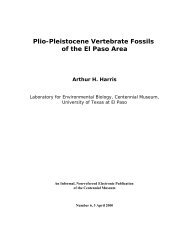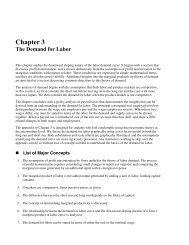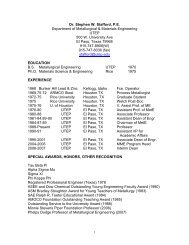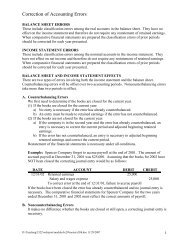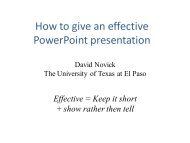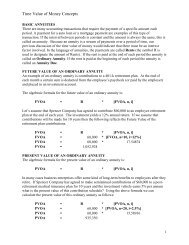Factors Affecting Speaking-Rate Adaptation in Task ... - CiteSeer
Factors Affecting Speaking-Rate Adaptation in Task ... - CiteSeer
Factors Affecting Speaking-Rate Adaptation in Task ... - CiteSeer
Create successful ePaper yourself
Turn your PDF publications into a flip-book with our unique Google optimized e-Paper software.
<strong>Factors</strong> <strong>Affect<strong>in</strong>g</strong> <strong>Speak<strong>in</strong>g</strong>-<strong>Rate</strong> <strong>Adaptation</strong> <strong>in</strong> <strong>Task</strong>-Oriented Dialogs<br />
Nigel G. Ward and S. Kumar Mamidipally<br />
Department of Computer Science<br />
University of Texas at El Paso<br />
nigelward@acm.org, neosrk@gmail.com<br />
Abstract<br />
Dialog systems should be able to automatically determ<strong>in</strong>e an<br />
appropriate speak<strong>in</strong>g rate for each utterance. In a small corpus<br />
of bill<strong>in</strong>g support dialogs we identified factors account<strong>in</strong>g for<br />
18% of the variation <strong>in</strong> agent speak<strong>in</strong>g rate. Simple adaptation<br />
to the user accounts for little, rather it is the dialog state and<br />
dialog acts <strong>in</strong> the local context which seem to matter more. 1<br />
Index Terms: speech rate selection, tempo, utterance-level,<br />
user model<strong>in</strong>g, accommodation<br />
1. Motivation<br />
Today most spoken dialog systems do not adapt the rate of their<br />
speech output. This is a problem <strong>in</strong> that different users may prefer<br />
to hear speech at different rates, and <strong>in</strong> that they may prefer<br />
different rates at different places <strong>in</strong> the dialog. Non-adaptive<br />
speak<strong>in</strong>g rate is largely unavoidable for recorded prompts, but<br />
it also seems that synthesized voices today are typically generated<br />
at a rate fixed for all utterances and for all users. To acheive<br />
adaptive speak<strong>in</strong>g rate we need a model of what rate is appropriate<br />
<strong>in</strong> what circumstances.<br />
This paper builds on an earlier study of speak<strong>in</strong>g rate adaptation<br />
[1]. That work found two factors predictive of the agent’s<br />
speak<strong>in</strong>g rate: the speed of the user’s <strong>in</strong>itial response and the<br />
user’s speak<strong>in</strong>g rate. Specifically, <strong>in</strong> a corpus of simulated directory<br />
assistance dialogs <strong>in</strong> Japanese, the agent’s speak<strong>in</strong>g rate<br />
dur<strong>in</strong>g number-giv<strong>in</strong>g was faster to the extent that the user had<br />
responded more swiftly and to the extent that the user had spoken<br />
more quickly. Multiple regression on these factors gave a<br />
formula which predicted the appropriate speak<strong>in</strong>g rate, and the<br />
predictions correlated fairly well (.46) with the rates observed <strong>in</strong><br />
good dialogs <strong>in</strong> the corpus. This work suggested that automatic<br />
speak<strong>in</strong>g rate adjustment is feasible.<br />
The current paper describes an exploration of whether<br />
speak<strong>in</strong>g rate adaptation is also feasible for longer, more complex<br />
dialogs.<br />
2. Method and Corpus<br />
We set out to develop a predictive model of speak<strong>in</strong>g rate, one<br />
us<strong>in</strong>g <strong>in</strong>formation about the course of the dialog so far to determ<strong>in</strong>e<br />
an appropriate rate for the next system utterance. Although<br />
factors affect<strong>in</strong>g speak<strong>in</strong>g rate <strong>in</strong> monologs and unstructured<br />
conversations have previously been identified [2, 3], our<br />
<strong>in</strong>terest is <strong>in</strong> task-oriented dialogs, <strong>in</strong> which people communicate<br />
to accomplish some bus<strong>in</strong>ess.<br />
1 This research was sponsored <strong>in</strong> part by NSF Grant No. 0415150.<br />
We thank David Novick and Anais Rivera for discussion and Guarav<br />
Garg for data analysis.<br />
Our approach was corpus based, us<strong>in</strong>g a bill<strong>in</strong>g-support<br />
corpus collected for another purpose [4], <strong>in</strong> which subjects were<br />
<strong>in</strong>structed to obta<strong>in</strong> balance <strong>in</strong>formation, to review recent transactions,<br />
and to make a payment. There were 20 students <strong>in</strong> the<br />
user role and one <strong>in</strong> the agent role. There were 733 utterances <strong>in</strong><br />
total. All subjects spoke <strong>in</strong> American English, although some<br />
with heavy Spanish accents. The person chosen for the agent<br />
role was a student who had a pleasant manner, had customer<br />
service experience, and seemed generally socially adept.<br />
An <strong>in</strong>itial impressionistic review of this corpus revealed that<br />
the agent’s speak<strong>in</strong>g rate varied greatly, both across dialogs and<br />
with<strong>in</strong> dialogs. This seemed to generally be deliberate, not a<br />
mere artifact of the words she was say<strong>in</strong>g, and not a mere artifact<br />
of performance problems (although there were cases where<br />
she slowed as she fumbled to look up <strong>in</strong>formation for the customer).<br />
3. Measur<strong>in</strong>g <strong>Speak<strong>in</strong>g</strong> <strong>Rate</strong><br />
The proper estimation of speak<strong>in</strong>g rate is a matter of some complexity<br />
[5, 6, 7, 8], but many of the complicat<strong>in</strong>g factors probably<br />
are less significant for rate at the utterance level, our focus<br />
here. Preferr<strong>in</strong>g to have a convenient measure over a perfect<br />
one, we used the estimates of syllables per second given by<br />
the “mrate” program [9]. However mrate is unsuitable for very<br />
short utterances, so we excluded utterances last<strong>in</strong>g less than .5<br />
seconds from the analysis, except where noted. We were also<br />
concerned that the values given by mrate may be mislead<strong>in</strong>g<br />
unless corrected for filled pauses, so we did a quick validation,<br />
label<strong>in</strong>g all utterances <strong>in</strong> the corpus us<strong>in</strong>g a 4 step perceptual<br />
judgment of rate. We found that even raw mrate had a .84 correlation<br />
with these judgments, which we decided was adequate<br />
for our purposes.<br />
On this measure the agent’s speak<strong>in</strong>g rate averaged 4.31<br />
and had a standard deviation of 0.67. The per-dialog averages<br />
ranged from 4.10 to 4.86.<br />
4. User <strong>Speak<strong>in</strong>g</strong> <strong>Rate</strong> as a Predictive<br />
Factor<br />
Based on the Japanese study we expected the user’s speak<strong>in</strong>g<br />
rate to be a strong predictive factor. Specifically we expected the<br />
agent to talk faster <strong>in</strong> response to users who were talk<strong>in</strong>g faster.<br />
At the level of dialogs there was <strong>in</strong>deed a strong correlation,<br />
.60.<br />
However, look<strong>in</strong>g at the rates of <strong>in</strong>dividual utterances, the<br />
picture is more complex and the correlations far weaker. The<br />
correlation between the agent’s speak<strong>in</strong>g rate on an utterance<br />
and the user’s speak<strong>in</strong>g rate on the immediately previous utterance<br />
was a mere .025. The correlation with the cumulative average<br />
of the user’s rate across all previous utterances was some-
Figure 1: Relations among <strong>Factors</strong> <strong>in</strong>volved <strong>in</strong> Inference of the Appropriate <strong>Speak<strong>in</strong>g</strong> <strong>Rate</strong> for the System. Observable and known<br />
factors are at the far left and far right.<br />
what better: .13. Th<strong>in</strong>k<strong>in</strong>g that the pattern of adaptation might<br />
be obscured by the diversity of dialog acts <strong>in</strong> the corpus, we<br />
exam<strong>in</strong>ed also one specific k<strong>in</strong>d of utterance, that <strong>in</strong> which the<br />
agent reads out recent transactions (e.g. you have a charge of<br />
$120 to Wal-Mart . . . ). As these were similar across all the<br />
dialogs, were among the longest agent utterances, and occurred<br />
near the end <strong>in</strong> almost all dialogs, we expected to see a clear correlation<br />
between cumulative average user rate and the operator<br />
rate on these utterances, however the correlation was negative:<br />
–.20.<br />
At this po<strong>in</strong>t we realized that simple adaptation was <strong>in</strong>adequate<br />
to expla<strong>in</strong> what was go<strong>in</strong>g on, and took a step back to<br />
consider what other factors might be <strong>in</strong>volved.<br />
5. Relations among <strong>Factors</strong> Involved <strong>in</strong><br />
<strong>Speak<strong>in</strong>g</strong> <strong>Rate</strong> <strong>Adaptation</strong><br />
Based on a literature review and our own observations, Figure 1<br />
shows how agent speak<strong>in</strong>g rate could be affected by user speak<strong>in</strong>g<br />
rate and other factors, display<strong>in</strong>g some of the likely causal<br />
and <strong>in</strong>ferential relations. In this section we discuss two reasons<br />
to expect agent speak<strong>in</strong>g rate (r) to correlate with user speak<strong>in</strong>g<br />
rate (a), and also discuss factors that may complicate this<br />
relation.<br />
The most direct causal path, a-c-j-l-r, represents pure social<br />
accommodation [10, 11]. While it is conceivable that speakers<br />
have a reflex response to match their dialog partner’s speak<strong>in</strong>g<br />
rate, here we assume that such adaptation is generally mediated<br />
by <strong>in</strong>ference. As seen <strong>in</strong> the figure, the user’s choice of speak<strong>in</strong>g<br />
rate (c) may reflect his (current) <strong>in</strong>formation-uptake capabilities<br />
or display his chosen dialog personality, such as whether<br />
he wants to be <strong>in</strong> control of the dialog. Such factors are represented<br />
as “user’s explicit desires” (j) <strong>in</strong> the figure, and good<br />
agents can probably form a user model <strong>in</strong>clud<strong>in</strong>g these from the<br />
user’s speech.<br />
However such factors are not directly <strong>in</strong>ferable from the raw<br />
speak<strong>in</strong>g rate, which can be affected by extraneous factors (b),<br />
such as the time the user takes to formulate the utterance before<br />
he beg<strong>in</strong>s talk<strong>in</strong>g (the reaction time); momentary user confusion,<br />
for example when try<strong>in</strong>g to f<strong>in</strong>d an account number to read<br />
aloud; and syntactic, lexical, and phonetic features such as the<br />
number of stressed syllables <strong>in</strong> the utterance. Normalization for<br />
typical user behavior is doubtless also required, as user speak<strong>in</strong>g<br />
styles differ. These differences can be complex, for example<br />
it seems that some users handle formulation difficulties by reduc<strong>in</strong>g<br />
their speak<strong>in</strong>g rate while others tend to start quickly but<br />
then pause and repair; here the <strong>in</strong>formation content and the impression<br />
given might be similar, but the raw speak<strong>in</strong>g rate could<br />
be very different.<br />
Another complication is that the socially appropriate rate<br />
(l) may be constra<strong>in</strong>ed by the persona of the dialog system (k).<br />
This may be determ<strong>in</strong>ed statically by the corporate image that<br />
needs to be portrayed or by the need to model for the user how<br />
to talk slowly and clearly, so as <strong>in</strong>crease the chances of successful<br />
speech recognition. It may also also be determ<strong>in</strong>ed dynamically,<br />
for example an agent may deliberately talk more slowly<br />
to encourage the user to feel comfortable or calm down.<br />
There is a second causal path by which the user’s speak<strong>in</strong>g<br />
rate (a) could affect the agent’s speak<strong>in</strong>g rate (r): by <strong>in</strong>directly<br />
giv<strong>in</strong>g clues to the user’s cognitive state (e). That is, people who<br />
are speak<strong>in</strong>g faster can be assumed to be more alert and have<br />
a lighter cognitive load. A less loaded user would of course<br />
be generally more able to quickly understand (g), and as a result<br />
the most effective rate, that is the highest rate which would<br />
probably have little risk of caus<strong>in</strong>g the user to misunderstand<br />
(h), would be higher. There is a trade-off here — an agent or<br />
system should talk fast to save time, but not so fast as to cause<br />
time-wast<strong>in</strong>g user misunderstand<strong>in</strong>gs — and we could <strong>in</strong> pr<strong>in</strong>ciple<br />
compute the rate which maximizes expected efficiency.<br />
With reference to the figure, it is also possible to see why<br />
this might not turn out as we expected: other factors are likely<br />
to disrupt the correlation. For example the amount of new <strong>in</strong>formation<br />
to be conveyed <strong>in</strong> the agent’s utterance (f) could affect<br />
how likely the the user would be to readily understand it (g).
It is also likely that aspects of the dialog state (d) — such as<br />
time <strong>in</strong>to dialog (as a measure of the user’s familiarity with the<br />
agent’s voice), dialog act type, criticality (i), or the presence of<br />
recent misrecognitions [12] — could affect the user’s cognitive<br />
load or his propensity to understand.<br />
Apart from such user-related considerations, the agent’s<br />
speak<strong>in</strong>g rate could also be affected by the lexical content of<br />
the utterance (n) or considerations of dialog rhythm (m) such as<br />
desired utterance duration. In particular, an agent wish<strong>in</strong>g to reduce<br />
the <strong>in</strong>formation density of an utterance may do so without<br />
chang<strong>in</strong>g speak<strong>in</strong>g rate, by <strong>in</strong>stead paus<strong>in</strong>g more before talk<strong>in</strong>g,<br />
or by <strong>in</strong>terpolat<strong>in</strong>g low content semi-fixed phrases, for example<br />
by prefac<strong>in</strong>g some <strong>in</strong>formation with okay, if you’re ready I’ll go<br />
ahead and read them off to you rather than just here they are.<br />
6. Other Predictive <strong>Factors</strong><br />
Based on this understand<strong>in</strong>g of the likely relationships among<br />
the factors, ultimately we would like model the relations between<br />
the <strong>in</strong>terven<strong>in</strong>g variables and the observables. Do<strong>in</strong>g<br />
this would, however, require numerous difficult subjective judgments,<br />
so we chose to do someth<strong>in</strong>g simpler, to use Figure 1<br />
merely to suggest what factors to exam<strong>in</strong>e, reta<strong>in</strong><strong>in</strong>g the basic<br />
strategy of look<strong>in</strong>g for correlations between observable dialog<br />
properties and the agent speak<strong>in</strong>g rate. This section summarizes<br />
the tendencies seen; the details are <strong>in</strong> [13].<br />
We thought that swifter user reaction times would correlate<br />
with faster agent speak<strong>in</strong>g rates, as seen <strong>in</strong> the Japanese study<br />
[1]. As with user speak<strong>in</strong>g rate, these could plausibly affect<br />
agent speak<strong>in</strong>g rate both via a direct adaptation path and via<br />
an <strong>in</strong>ferred representation of user cognitive state, assum<strong>in</strong>g that<br />
users who respond faster are more alert. User reaction times<br />
were measured as the time from the end of the agent’s previous<br />
utterance to the start of the user’s utterance, with a lower bound<br />
of zero if this was negative, that is if there was an overlap, as<br />
happened 27% of the time. There was a positive correlation,<br />
of .09, mean<strong>in</strong>g that if the user took longer to respond then the<br />
operator would speak more quickly on the next turn, contrary to<br />
expectation. Correlation with cumulative average reaction time<br />
so far was also positive, although weaker, at .014.<br />
We also exam<strong>in</strong>ed other properties of the user’s utterances.<br />
We thought that disfluent user utterances would cue the agent to<br />
slow down, and there was a weak tendency for this. We thought<br />
that dispreferred user utterances, for example someth<strong>in</strong>g other<br />
than an answer <strong>in</strong> response to a direct question from the agent,<br />
would cue the agent to slow down, but <strong>in</strong> fact there was no such<br />
effect. We thought that longer user utterances would enable the<br />
agent to speak faster on her next utterance, reason<strong>in</strong>g that this<br />
would give her more time to formulate her next utterance, and<br />
<strong>in</strong> fact there was a slight correlation, .06, between the rate of the<br />
subsequent agent utterance and the length of the previous user<br />
utterance.<br />
We also looked for effects of the agent’s cognitive state and<br />
cognitive load. There was a tendency for longer utterances to<br />
have a slower speak<strong>in</strong>g rate (– .22 correlation), contrary to what<br />
is seen <strong>in</strong> unstructured conversations [3]. There was also a tendency<br />
for the agent to speak faster if she had more time to prepare,<br />
that is, a correlation (of .04) between her speak<strong>in</strong>g rate and<br />
her reaction time (aga<strong>in</strong>, with overlapped utterances counted as<br />
hav<strong>in</strong>g zero reaction time).<br />
F<strong>in</strong>ally we exam<strong>in</strong>ed the effects of utterance type (dialog<br />
act), and here many correlations were found. There was a strong<br />
tendency for clos<strong>in</strong>gs (e.g. is there anyth<strong>in</strong>g else I can help you<br />
with?, and thank you for call<strong>in</strong>g) to be much slower than the rest<br />
of the dialogs; the average rate was 3.6 versus 4.3 overall. There<br />
was a tendency for scripted prompts (e.g. how may I help you?,<br />
and can I have your account number please?) to be slightly<br />
faster than those generated on the fly. There was a tendency for<br />
answers to user questions to be slower. There was a tendency<br />
for the agent to speak slower when read<strong>in</strong>g out the list of transactions.<br />
There was a tendency for the agent to speak faster after<br />
a very short user utterance, which <strong>in</strong> these dialogs was usually<br />
an acknowledgment of an item <strong>in</strong> a list, lett<strong>in</strong>g the agent know<br />
that she could cont<strong>in</strong>ue on swiftly. There was a tendency for the<br />
agent to speak faster when produc<strong>in</strong>g utterances that started by<br />
acknowledg<strong>in</strong>g data provided by the user. There was a strong<br />
tendency for questions to be produced faster. This was probably<br />
due to the fact that, <strong>in</strong> this doma<strong>in</strong>, agent questions generally<br />
br<strong>in</strong>g little new <strong>in</strong>formation (e.g., okay, now how much would<br />
you like to pay?), although it may also be due <strong>in</strong> part to the<br />
fact that our agent, be<strong>in</strong>g bil<strong>in</strong>gual <strong>in</strong> Spanish and English, may<br />
have been us<strong>in</strong>g the f<strong>in</strong>al rate speed-up sometimes used to mark<br />
questions <strong>in</strong> Spanish.<br />
7. The Predictive Equation<br />
Runn<strong>in</strong>g multiple regression over a total of 17 factors, <strong>in</strong>clud<strong>in</strong>g<br />
all of those mentioned <strong>in</strong> Sections 4 and 6, we obta<strong>in</strong>ed a l<strong>in</strong>ear<br />
equation predict<strong>in</strong>g agent speak<strong>in</strong>g rate as a function of 14<br />
terms [13]. This model expla<strong>in</strong>ed 18% of the variance and had<br />
a significance F of < .0001, mean<strong>in</strong>g that this performance was<br />
almost certa<strong>in</strong>ly not due to chance. However, given the small<br />
size of our corpus this probably represented overfitt<strong>in</strong>g, so we<br />
also created a simpler model, us<strong>in</strong>g only the five factors which<br />
<strong>in</strong>dividually had significant correlations (p < .05) with agent<br />
speak<strong>in</strong>g rate:<br />
Predicted Agent <strong>Speak<strong>in</strong>g</strong> <strong>Rate</strong><br />
= 3.79 + .74T 2 + 0.68T 3 + 0.63T 4 + 0.82S + −0.04D<br />
In this equation T 2, T 3, and T 4 are b<strong>in</strong>ary features <strong>in</strong>dicat<strong>in</strong>g<br />
which subtask the user is currently engaged <strong>in</strong>, with the<br />
coefficients reflect<strong>in</strong>g the relative speeds, T 2, respond<strong>in</strong>g to the<br />
balance <strong>in</strong>quiry be<strong>in</strong>g faster than T 3, elicit<strong>in</strong>g payment <strong>in</strong>structions,<br />
and T 4, giv<strong>in</strong>g recent transactions. The lack of an explicit<br />
factor for T 5, the clos<strong>in</strong>g subtask, encodes the fact that it was<br />
by far the slowest. S is a b<strong>in</strong>ary feature that is true if the utterance<br />
was a scripted one: the positive weight here could reflect<br />
the ease of produc<strong>in</strong>g these, the prevalence of scripted prompts<br />
<strong>in</strong> simple question-answer exchanges, or the prevalence of such<br />
utterances early <strong>in</strong> the dialog. D is the duration of the agent utterance<br />
<strong>in</strong> seconds. This simpler equation had high significance<br />
(F < .000001) but accounted for only 15% of the variance,<br />
which is probably not enough to be directly useful.<br />
8. Directions for Future Work<br />
Our equations are unsophisticated l<strong>in</strong>ear comb<strong>in</strong>ations of factors<br />
which are obviously not <strong>in</strong>dependent, fail<strong>in</strong>g to reflect the<br />
likely <strong>in</strong>teractions (Figure 1). Creat<strong>in</strong>g a quantitative model that<br />
<strong>in</strong>cludes the <strong>in</strong>terven<strong>in</strong>g variables is one promis<strong>in</strong>g direction for<br />
future work.<br />
It might also be useful to consider the reciprocal process:<br />
not only must the agent adapt to the user, the agent may also<br />
need to consider how the user is simultaneously adapt<strong>in</strong>g to the<br />
agent.<br />
Incorporat<strong>in</strong>g better characterizations of the dialog states<br />
and dialog acts would probably also be valuable. For example,<br />
the agent appeared to speed up to <strong>in</strong>dicate completion of a
sub-task, and she appeared to slow down when giv<strong>in</strong>g dispreferred<br />
responses, for example uh, I don’t have any <strong>in</strong>formation<br />
for that date. With a f<strong>in</strong>er characterization of states and acts and<br />
a larger corpus we could exam<strong>in</strong>e such possible relations. We<br />
also should of course re-exam<strong>in</strong>e the tendencies noted above<br />
us<strong>in</strong>g a larger corpus.<br />
It may also be valuable to attempt to tie the speak<strong>in</strong>g rate<br />
adaptation problem to the user model<strong>in</strong>g problem. Various<br />
sources of <strong>in</strong>formation useful for model<strong>in</strong>g the user’s knowledge,<br />
needs, and desired <strong>in</strong>teraction style (e, g, j) are likely to<br />
be useful here also. For example, his familiarity with the doma<strong>in</strong><br />
of discourse may be <strong>in</strong>ferable from his vocabulary choice;<br />
his degree of understand<strong>in</strong>g and comfort <strong>in</strong> the dialog may be<br />
<strong>in</strong>ferable from his prosody; his desired pace of <strong>in</strong>teraction may<br />
be <strong>in</strong>ferable from his turn-tak<strong>in</strong>g style, for example the propensity<br />
to overlap and the propensity to back-channel; and his language<br />
comprehension ability may be <strong>in</strong>ferable from his accent,<br />
although <strong>in</strong> this corpus a foreign accent <strong>in</strong> speech does not seem<br />
to reliably predict comprehension difficulties.<br />
The method of analysis assumed that all utterances are<br />
equally <strong>in</strong>formative, but this is probably not the case. On the<br />
one hand, properties of some utterances may reflect merely transient<br />
states. For example, after the user slows down at a disfluency<br />
po<strong>in</strong>t (due to formulation problems, or look<strong>in</strong>g up a number),<br />
he often saliently speeds up, as if to say “that was just a<br />
momentary problem; now I’m fast and alert aga<strong>in</strong>”; his momentary<br />
slow<strong>in</strong>g probably should not affect the agent’s rate. Similarly<br />
a crisp excuse me? can cue a repetition, which should of<br />
course come slower, but this should not necessarily affect the<br />
way the agent behaves <strong>in</strong> subsequent utterances. On the other<br />
hand there may be “benchmark” utterances, perhaps greet<strong>in</strong>gs<br />
for example, <strong>in</strong> which the user’s speak<strong>in</strong>g rate or other speech<br />
properties reliably <strong>in</strong>dicate the user’s personality, state, and conversational<br />
style, and thereby “set the tone” for the whole conversation.<br />
9. Summary and Conclusions<br />
We set out to develop a model of agent speak<strong>in</strong>g rate adaptation,<br />
suitable for determ<strong>in</strong><strong>in</strong>g how fast the utterances of a spoken dialog<br />
system should be. We identified factors which account for<br />
some of the variation <strong>in</strong> speak<strong>in</strong>g rate.<br />
However the model developed is only weakly predictive.<br />
The ma<strong>in</strong> reasons for this result, <strong>in</strong> contrast to the success <strong>in</strong> the<br />
earlier study, probably relate to the nature of the dialogs. The<br />
earlier study used directory assistance dialogs, which are almost<br />
the simplest possible task-oriented dialogs. Such dialogs have<br />
little variation on most of the factors seen <strong>in</strong> Figure 1. In a<br />
sense, the agents <strong>in</strong> those dialogs had so little <strong>in</strong>formation to go<br />
on that they could do no more than simple adaptations, and these<br />
were easy to model. Another likely partial explanation relates<br />
to the subject populations and record<strong>in</strong>g environments: <strong>in</strong> the<br />
earlier study the subjects varied <strong>in</strong> occupation and age, called<br />
from a variety of environments and used a variety of telephony<br />
equipment, thus there were more large differences <strong>in</strong> user dialog<br />
style and <strong>in</strong> agent behavior, and these were easier to model.<br />
Among the various factors affect<strong>in</strong>g speak<strong>in</strong>g rate, we expected<br />
the major determ<strong>in</strong>ants to be those related to adapt<strong>in</strong>g<br />
to the user. This was based on our belief that speak<strong>in</strong>g rate<br />
is largely <strong>in</strong>dependent of the semantic and pragmatic course of<br />
the dialog, and is <strong>in</strong>stead part of a separate dimension of social<br />
dynamics. Had this been true it would have been good<br />
news for spoken dialog systems development: it would have<br />
meant that we could build an autonomous plug-<strong>in</strong> enabl<strong>in</strong>g the<br />
dialog manager to chose an appropriate rate for each utterance,<br />
which would support the easy retrofitt<strong>in</strong>g of exist<strong>in</strong>g spoken dialog<br />
systems to do adaptive speak<strong>in</strong>g rate selection.<br />
But <strong>in</strong> fact the most predictive factors were those relat<strong>in</strong>g to<br />
the dialog state and the quantity, type, and newness of the <strong>in</strong>formation<br />
to convey. This suggests that proper control of speak<strong>in</strong>g<br />
rate for task-oriented systems will probably depend on carefully<br />
model<strong>in</strong>g and represent<strong>in</strong>g the <strong>in</strong>teractions between dialog acts<br />
and dialog state. The bad news is that this is can be doma<strong>in</strong>specific;<br />
the good news is that this can be done with exist<strong>in</strong>g<br />
technology.<br />
10. References<br />
[1] Ward, Nigel and Satoshi Nakagawa, 2004. Automatic User-<br />
Adaptive <strong>Speak<strong>in</strong>g</strong> <strong>Rate</strong> Selection. International Journal of<br />
Speech Technology, 7, pp 235–238.<br />
[2] Quené, Hugo. 2005. Model<strong>in</strong>g of between-speaker and<br />
with<strong>in</strong>-speaker variation <strong>in</strong> spontaneous speech tempo. Interspeech<br />
2005.<br />
[3] Yuan, Jiahong, Mark Liberman, and Christopher Cieri. Towards<br />
an Integrated Understand<strong>in</strong>g of <strong>Speak<strong>in</strong>g</strong> <strong>Rate</strong> <strong>in</strong><br />
Conversation. Interspeech 2006, pp 541-544.<br />
[4] Ward, Nigel, Anais G. Rivera, Karen Ward and David G.<br />
Novick, 2005. Root Causes of Lost Time and User Stress<br />
<strong>in</strong> a Simple Dialog System. Interspeech 2005.<br />
[5] Pfitz<strong>in</strong>ger, Hartmut R., 1998. Local Speech <strong>Rate</strong> as a Comb<strong>in</strong>ation<br />
of Syllable and Phone <strong>Rate</strong>. ICSLP 1998, vol. 3,<br />
pp. 1087-1090.<br />
[6] Pellegr<strong>in</strong>o, Francois, J. Far<strong>in</strong>as and J.-L. Rouas, 2004. Automatic<br />
Estimation of <strong>Speak<strong>in</strong>g</strong> <strong>Rate</strong> <strong>in</strong> Multil<strong>in</strong>gual Spontaneous<br />
Speech. Speech Prosody 2004, pp 517–520.<br />
[7] Koreman, Jacques. 2006. Perceived speech rate: the effects<br />
of articulation rate and speak<strong>in</strong>g style <strong>in</strong> spontaneous<br />
speech. Journal of the Acoustical Society of America,<br />
119(1), pp 582-596.<br />
[8] Dekens, Tomas, Mike Demol, Werner Verhelst, and Piet<br />
Verhoeve. A Comparative Study of Speech <strong>Rate</strong> Estimateion<br />
Techniques. Interspeech 2007.<br />
[9] Morgan, Nelson and Eric Fosler-Lussier, 1998. Comb<strong>in</strong><strong>in</strong>g<br />
Multiple Estimators of <strong>Speak<strong>in</strong>g</strong> <strong>Rate</strong>. ICASSP ’98, pp<br />
721-724. IEEE.<br />
[10] Giles, Howard, Anthony Mulac, James J. Bradac and Patricia<br />
Johnson, 1987. Speech Accommodation Theory: The<br />
First Decade and Beyond. <strong>in</strong> Communication Yearbook 10,<br />
M. L. McLaughl<strong>in</strong>, ed., Sage Publications, pp 13–48.<br />
[11] Buller, David B. and R. Kelly Aune. The Effects of Speech<br />
<strong>Rate</strong> Similarity on Compliance: Application of Communication<br />
Accommodation Theory. Western Journal of Communication,<br />
56, pp 37–53, 1992.<br />
[12] Dioub<strong>in</strong>a, Olga I, 2004. Prosody of Dialogues: Influence<br />
of Recognition Failure on Local Speech <strong>Rate</strong>. Speech<br />
Prosody 2004, pp 275–278.<br />
[13] Mamidipally, Soujanya Kumar, 2006. <strong>Speak<strong>in</strong>g</strong> <strong>Rate</strong><br />
<strong>Adaptation</strong> for <strong>Task</strong>-Based Spoken Dialogue Systems. University<br />
of Texas at El Paso, Computer Science Department<br />
Masters Thesis.



